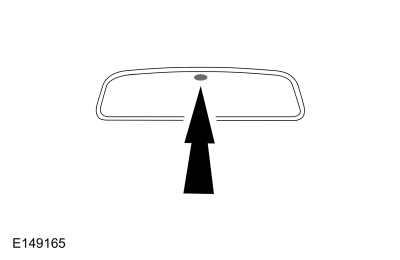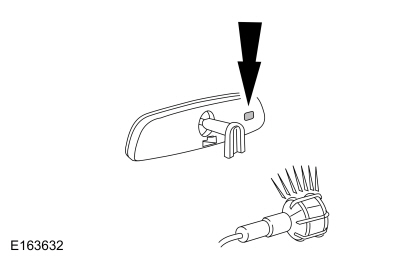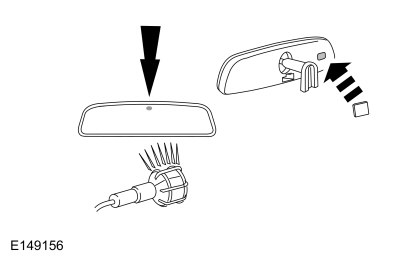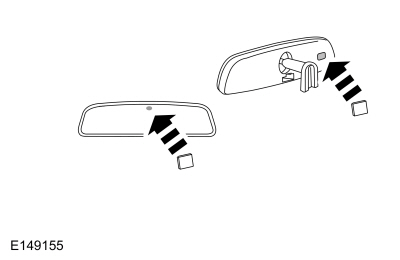Ford Fiesta: Rear View Mirrors / Rear View Mirrors. Diagnosis and Testing
Symptom Chart(s)
Symptom Chart: Rear View Mirrors - Exterior, Power
| Condition | Possible Sources | Actions |
|---|---|---|
| Mirrors fold inward due to wind pressure | Mirror structural bracket is damaged |
INSPECT the mirror for structural damage. If necessary, INSTALL a new mirror. REFER to: Exterior Mirror (501-09 Rear View Mirrors, Removal and Installation). |
| The exterior mirror turn indicator is inoperative or always on |
|
REFER to: Turn Signal and Hazard Lamps (417-01 Exterior Lighting, Diagnosis and Testing). |
| Both exterior mirrors are inoperative | Refer to the Pinpoint Test | GO to Pinpoint Test A |
| A single exterior mirror is inoperative | Refer to the Pinpoint Test | GO to Pinpoint Test B |
| A single exterior mirror does not operate in all directions | Refer to the Pinpoint Test | GO to Pinpoint Test C |
Symptom Chart: Rear View Mirrors - Exterior, Heated
| Condition | Possible Sources | Actions |
|---|---|---|
| The heated exterior mirror is inoperative | Refer to the Pinpoint Test | GO to Pinpoint Test D |
Symptom Chart: Rear View Mirrors - Interior
| Condition | Possible Sources | Actions |
|---|---|---|
| The interior mirror is blemished | Interior mirror glass/housing is dirty |
NOTE: Do not clean the housing or glass of any mirror with harsh abrasives, fuel or other petroleum-based cleaning products. CLEAN the affected interior mirror surface. |
| The interior mirror is damaged |
INSPECT the interior mirror damage. If needed, INSTALL a new interior rear view mirror. REFER to: Interior Rear View Mirror (501-09 Rear View Mirrors, Removal and Installation). |
|
| The interior auto-dimming interior mirror does not operate correctly | Refer to the pinpoint test | GO to Pinpoint Test E |
Symptom Chart: Noise, Vibration and Harshness (NVH)
| Condition | Possible Sources | Actions |
|---|---|---|
| Exterior mirror vibrates/loose | Exterior mirror motor screws loose |
REMOVE mirror glass and TIGHTEN the exterior mirror motor screws. REFER to: Exterior Mirror (501-09 Rear View Mirrors, Removal and Installation). |
| Exterior mirror mounting nuts loose |
TIGHTEN the exterior mirror mounting nuts. REFER to: Exterior Mirror (501-09 Rear View Mirrors, Removal and Installation). |
|
| Exterior mirror glass loose |
PRESS the center of the exterior mirror
glass up, down, left and right to make sure the exterior mirror glass
is seated correctly. If the exterior mirror glass is still loose, REMOVE
the exterior mirror glass and INSPECT the exterior mirror backing plate
for damage. If the exterior mirror backing plate is damaged, INSTALL a
new exterior mirror glass. REFER to: Exterior Mirror (501-09 Rear View Mirrors, Removal and Installation). |
|
| Aftermarket air deflector/stone shields | If possible, REMOVE aftermarket air deflector/stone shield, then ROAD TEST the vehicle. If the concern is no longer present, ADVISE the customer that aftermarket components were causing undesired vibration. | |
| Wind noise | Foam gasket between exterior mirror housing and door is misaligned or damaged |
VERIFY the gasket is in good condition.
If necessary, REPOSITION the foam gasket between exterior rear view
mirror housing and door frame or REPAIR the foam gasket as needed. The
foam gasket is not serviceable and if it cannot be repaired, INSTALL a
new exterior mirror. REFER to: Exterior Mirror (501-09 Rear View Mirrors, Removal and Installation). |
| Exterior mirror is not correctly fitted to the door | VERIFY there are no gaps between the exterior mirror and the door. If necessary, LOOSEN the exterior mirror nuts and REPOSITION the exterior mirror as necessary. | |
| Exterior mirror cover |
VERIFY the exterior mirror cover is not
loose or broken. If necessary, INSTALL a new exterior mirror cover. REFER to: Exterior Mirror (501-09 Rear View Mirrors, Removal and Installation). |
|
| The interior mirror vibrates/loose | Interior mirror mounting loose |
If the mirror is still on the windshield, do not remove.
ATTEMPT to fully seat the mirror first. If the mirror is still loose or
vibrates, REMOVE and REINSTALL the mirror. If the condition still
exists, INSTALL a new interior mirror. REFER to: Interior Rear View Mirror (501-09 Rear View Mirrors, Removal and Installation). |
Pinpoint Tests
Both Exterior Mirrors Are Inoperative
Refer to Wiring Diagrams Cell 124 for schematic and connector information.
Normal Operation and Fault Conditions
CJB fuse 16 (5A) supplies voltage to the exterior mirror control switch at all times. The exterior mirror control switch supplies voltage and ground to the exterior mirror motors based on switch inputs.
Possible Sources
- Fuse
- Wiring, terminals or connectors
- Exterior mirror control switch
Visual Inspection and Diagnostic Pre-Checks
Inspect CJB fuse 16 (5A).
PINPOINT TEST A: BOTH EXTERIOR MIRRORS ARE INOPERATIVE
| A1 CHECK FOR VOLTAGE TO THE MASTER WINDOW CONTROL SWITCH | ||||||||||
Is the voltage greater than 11 volts?
|
||||||||||
| A2 CHECK FOR GROUND AT THE MASTER WINDOW CONTROL SWITCH | ||||||||||
Is the resistance less than 3 ohms?
|
||||||||||
| A3 CHECK THE EXTERIOR REAR VIEW MIRROR COMMON CIRCUIT FOR AN OPEN | ||||||||||
Is the resistance less than 3 ohms?
|
A Single Exterior Mirror Is Inoperative
Refer to Wiring Diagrams Cell 124 for schematic and connector information.
Normal Operation and Fault Conditions
The LH and RH
exterior mirrors share a common circuit that is used for up/down and
left/right movement. See Rear View Mirrors - Exterior, Power
REFER to: Rear View Mirrors - System Operation and Component Description (501-09 Rear View Mirrors, Description and Operation).
Possible Sources
- Wiring, terminals or connectors
- Exterior mirror control switch
- Exterior mirror motor
- Exterior mirror
PINPOINT TEST B: A SINGLE EXTERIOR MIRROR IS INOPERATIVE
| B1 CHECK THE EXTERIOR MIRROR CONTROL SWITCH | ||||||||||||||||
Does the exterior mirror control switch pass the component test?
|
||||||||||||||||
| B2 CHECK THE EXTERIOR MIRROR COMMON CIRCUIT FOR AN OPEN AT THE EXTERIOR MIRROR | ||||||||||||||||
Is the resistance less than 3 ohms?
|
A Single Exterior Mirror Does Not Operate In All Directions
Refer to Wiring Diagrams Cell 124 for schematic and connector information.
Normal Operation and Fault Conditions
The exterior mirror control switch supplies voltage and ground to the LH and RH
exterior mirrors to control movement. Each mirror contains a
horizontal and a vertical motor. The exterior rear view mirror switch
controls movement by reversing polarity of the voltage and ground
circuits being supplied to each motor. See Rear View Mirrors - Exterior,
Power
REFER to: Rear View Mirrors - System Operation and Component Description (501-09 Rear View Mirrors, Description and Operation).
Possible Sources
- Wiring, terminals or connectors
- Exterior mirror control switch
- Exterior mirror motor
- Exterior mirror
PINPOINT TEST C: A SINGLE MIRROR DOES NOT OPERATE IN ALL DIRECTIONS
| C1 CHECK THE EXTERIOR MIRROR MOVEMENT | ||||||||||||||||||||||||||||
Do the exterior mirrors move corresponding to the exterior mirror control switch?
|
||||||||||||||||||||||||||||
| C2 CHECK THE EXTERIOR MIRROR CONTROL SWITCH | ||||||||||||||||||||||||||||
Does the exterior mirror control switch pass the component test?
|
||||||||||||||||||||||||||||
| C3 CHECK THE EXTERIOR MIRROR CONTROL CIRCUITS FOR A SHORT TO VOLTAGE | ||||||||||||||||||||||||||||
Is any voltage present?
|
||||||||||||||||||||||||||||
| C4 CHECK THE EXTERIOR MIRROR CONTROL CIRCUITS FOR AN OPEN | ||||||||||||||||||||||||||||
Are the resistances less than 3 ohms?
|
||||||||||||||||||||||||||||
| C5 CHECK THE EXTERIOR MIRROR CONTROL CIRCUITS FOR A SHORT TOGETHER | ||||||||||||||||||||||||||||
Are the resistances greater than 10,000 ohms?
|
The Heated Exterior Mirror Is Inoperative
Refer to Wiring Diagrams Cell 56 for schematic and connector
information. Refer to Wiring Diagrams Cell 124 for schematic and
connector information.
Normal Operation and Fault Conditions
See Rear View Mirrors - Exterior, Heated
REFER to: Rear View Mirrors - System Operation and Component Description (501-09 Rear View Mirrors, Description and Operation).
Possible Sources
- Fuse
- Wiring, terminals or connectors
- Exterior mirror glass
- Exterior mirror
Visual Inspection and Diagnostic Pre-Checks
- Inspect the inoperative exterior mirror housing and glass for damage.
- Inspect CJB fuse 25 (7.5A).
PINPOINT TEST D: THE HEATED EXTERIOR MIRROR IS INOPERATIVE
| D1 CHECK THE OPERATION OF THE REAR WINDOW DEFROST SYSTEM | ||||||||||||||||
Does the temperature of the rear window glass rise?
|
||||||||||||||||
| D2 CHECK THE OPERATION OF THE HEATED EXTERIOR MIRRORS | ||||||||||||||||
Does at least one heated mirror operate correctly?
|
||||||||||||||||
| D3 CHECK THE VOLTAGE TO THE HEATED EXTERIOR MIRROR | ||||||||||||||||
Is the voltage greater than 11 volts?
|
||||||||||||||||
| D4 CHECK THE EXTERIOR MIRROR GROUND CIRCUIT FOR AN OPEN | ||||||||||||||||
Is the resistance less than 3 ohms?
|
The Interior Auto-Dimming Mirror Does Not Operate Correctly
Refer to Wiring Diagrams Cell 124 for schematic and connector information.
Normal Operation and Fault Conditions
See Rear View Mirrors - Interior, Auto-Dimming
REFER to: Rear View Mirrors - System Operation and Component Description (501-09 Rear View Mirrors, Description and Operation).
Possible Sources
- Fuse
- Wiring, terminals or connectors
- Interior auto-dimming mirror
- Reverse lamp concern
- Incorrect interior auto-dimming mirror orientation
PINPOINT TEST E: THE INTERIOR AUTO-DIMMING MIRROR DOES NOT OPERATE CORRECTLY
| E1 CHECK THE OPERATION OF THE REVERSING LAMPS | ||||||||||
Do the reversing lamps illuminate only when the selector lever is in reverse ?
|
||||||||||
| E2 INSPECT THE INTERIOR AUTO-DIMMING MIRROR FOR PROPER INSTALLATION | ||||||||||
Is the rearward facing sensor at the top of the interior auto-dimming mirror glass?
|
||||||||||
| E3 VERIFY THE FORWARD AND REARWARD FACING SENSORS ARE NOT BLOCKED | ||||||||||
Are either of the sensors blocked?
|
||||||||||
| E4 CHECK THE OPERATION OF THE INTERIOR AUTO-DIMMING MIRROR - DAYLIGHT CONDITIONS | ||||||||||
Does the mirror adjust to a high reflectance (clear) state?
|
||||||||||
| E5 CHECK THE OPERATION OF THE INTERIOR AUTO-DIMMING MIRROR - NIGHTTIME CONDITIONS WITH GLARE | ||||||||||
Does the mirror adjust to a low reflectance (dark) state?
|
||||||||||
| E6 CHECK THE OPERATION OF THE INTERIOR AUTO-DIMMING MIRROR - NIGHTTIME CONDITIONS WITHOUT GLARE | ||||||||||
Does the mirror adjust to a high reflectance (clear) state?
|
||||||||||
| E7 CHECK THE OPERATION OF THE INTERIOR AUTO-DIMMING MIRROR - NIGHTTIME CONDITIONS WITH GLARE AND THE VEHICLE IN REVERSE | ||||||||||
Does the mirror adjust to a high reflectance (clear) state after reverse was selected?
|
||||||||||
| E8 CHECK FOR VOLTAGE TO THE INTERIOR AUTO-DIMMING MIRROR | ||||||||||
Is the voltage greater than 11 volts?
|
||||||||||
| E9 CHECK FOR GROUND TO THE INTERIOR AUTO-DIMMING MIRROR | ||||||||||
Is the resistance less than 3 ohms?
|
||||||||||
| E10 CHECK FOR VOLTAGE TO THE INTERIOR AUTO-DIMMING MIRROR REVERSE CIRCUIT | ||||||||||
Is the voltage greater than 11 volts?
|
 Rear View Mirrors - System Operation and Component Description. Description and Operation
Rear View Mirrors - System Operation and Component Description. Description and Operation
System Operation
Rear View Mirrors - Exterior, Power
The LH and RH exterior mirror glass movement is controlled by the
exterior mirror control switch and the LH and RH exterior mirror motors...
 Interior Rear View Mirror. Removal and Installation
Interior Rear View Mirror. Removal and Installation
Special Tool(s) /
General Equipment
501-025Installer, Rear View Mirror
501-190Remover, Auto Dimming Rear View Mirror
501-191Installer, Rear View Mirror
501-D118A
(501-D118)
Mirror Remover
Removal
NOTE:
Removal steps in this procedure may contain installation details...
Other information:
Ford Fiesta 2014 - 2019 Service Manual: Front Seat Backrest. Removal and Installation
Special Tool(s) / General Equipment Feeler Gauge Flat Headed Screw Driver Locking Pliers Removal WARNING: The following procedure describes critical repair steps required for correct seat component installation...
Ford Fiesta 2014 - 2019 Service Manual: Module Programming. General Procedures
Check NOTE: Perform the following pre-checks to make sure module programming completes without errors. NOTE: Starting the engine prior to creating a programming session may prevent certain part number information from being inhaled by the IDS ...
Categories
- Manuals Home
- Ford Fiesta Service Manual (2014 - 2019)
- Manual Transmission - 6-Speed Manual Transmission – B6
- Camshafts. Removal and Installation
- Front Suspension
- Maintenance Schedules
- Climate Control System - General Information
Rear Wheel Speed Sensor. Removal and Installation
Removal
NOTE: Removal steps in this procedure may contain installation details.
Remove the retainer and pull the rear splash shield outward. Disconnect the electrical connector and detach the wiring retainer.
Disconnect the electrical connector and detach the wiring retainer.






